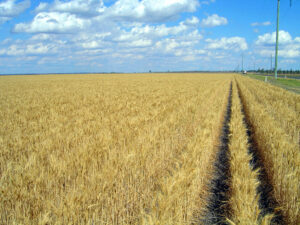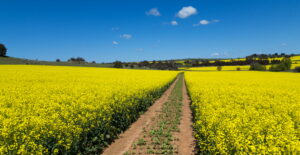Chicago wheat markets and grain sellers alike had a very ordinary Friday. Locally, prices quoted reflected the fall in the United States, but the basis has strengthened with weather outlooks seemingly discouraging selling.
A few factors came together on Friday to see wheat markets post a 4% decline to finish the week. The USDA outlook posted a large increase in expected wheat acreage this year. Figure 1 shows forecast wheat acreage in the US, which is up 8.5% for the 2023 cropping season.
As reported in the Mecardo market comment on Friday the increase in United States acreage, and a return to normal yields, are expected to see wheat production increase up over 10%. This, along with some commentary out of Russia about increasing exports was enough to see wheat futures crash lower.
In our terms, Chicago Soft Red Winter (SRW) Futures are sitting at $385/t on Monday, back at late January levels. The Aussie dollar slipping under 69¢ has helped support values in our terms in the face of declining US markets.
Cash markets have held much better than SRW early this week. Figure 2 shows Geelong Australian premium Wheat (APW) has declined but held at close to $420/t. This pushed the Geelong ‘basis’, or premium to SRW to a new season high of $33/tonne. There might be some support coming from the need to fill ships, but sluggish selling behaviour from growers will also be contributing.
The dry autumn forecast combined with lower prices, will always see growers hold onto their old crop, and resist selling the new crop. Figure 3 shows the Bureau of Meteorology’s autumn climate outlook. There is a low chance of above-average rainfall for almost all of Australia’s cropping zones.
Despite the fact Australia has had another record crop, a dry autumn will always see growers hold grain to take advantage of the expected ‘drought premium’. After such a good crop, it won’t be a huge premium, but exports pace has been good this year, and the expected carryover isn’t huge. This means there will be a growing premium if we have a light year for production.
What does it mean?
A seasonal basis high, even if prices are a little lower, is a good sell signal for those still holding onto wheat. As outlined a couple of weeks ago, international prices are still historically strong, and there is some downside with a better cropping year in the US.
There is still a 30% chance of a wetter-than-average autumn. Even close-to-average autumn rainfall would see the basis ease back.
Have any questions or comments?
Key Points
- A combination of US forecasts and Russian commentary saw wheat fall heavily on Friday.
- Local prices have eased, but the basis at Geelong hit a seasonal high on Monday.
- The dry autumn forecast is helping support wheat prices, but there is still downside possible.
Click on figure to expand
Click on figure to expand
Click on figure to expand
Data sources: ABS, USDA, Refinitiv, Bureau of Meteorology, Mecardo















